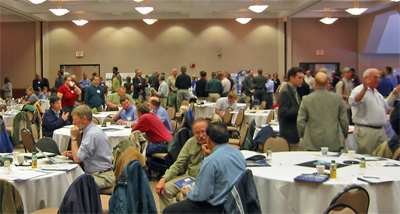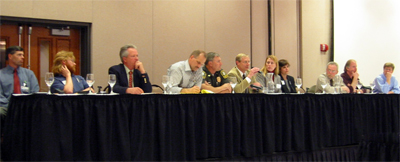Search For The Magic Bullet (7th in a series): Where The Wild Things Are
It was amazing to witness. Connecticut's leading experts on all things wild taking turns to report on the status of the state's wildlife--and what could be our last chance to preserve nature pushed to the brink.

Some 250 people, including wildlife biologists, government agencies, environmental groups, teachers, students and the public, came to UCONN Storrs yesterday for the First Annual CT Wildlife Conservation Conference. The day capped a multi-year team effort to answer a challenge from the US Congress to assemble our knowledge of the state's wild species, population trends and threats, research needs and tools and implement a new conservation plan that addresses urgent conservation needs.
For anyone with even a passing interest in wild things, the knowledge team members shared was both inspiring and stunning. Together, they told a story of the state's remarkable natural diversity with a passion that was often starkly revealing. Many habitats that have for centuries enriched our lives, and species that have long symbolized the best of wild Connecticut, now teeter on the brink of extirpation from the state, if not extinction from the earth.

On the dais were a team of biologists and conservationists who worked to prepare Connecticut's Wildlife Conservation Strategy. From left, Tom Savoy, CT DEP, spoke about marine fisheries; Chris Elphick, UConn, landbirds; Milan Bull, CT Audubon, waterbirds; David Wagner, UConn, invertebrates; CT State Environmental Conservation Police Officer; Bill Hyatt, CT DEP, inland fisheries; Jenny Dickson, CT DEP, bats and small mammals; Julie Victoria, CT DEP, freshwater mussels; Steve Broderick, UConn, community outreach; Hank Gruner, Science Center of CT, reptiles & amphibians; Chet Arnold, UConn/CLEAR, land use education and research. Not pictured: Paul Rego, CT DEP, large mammals; Nancy Murray, CT DEP, natural diversity database; Karen Terwilliger, challenges & opportunities.
Current Trends
Chris Elphick noted that one in three of Connecticut's landbird species for which data is available have declined over the past 35 years. Once familiar birds such as the Wood Thrush, Baltimore Oriole, Scarlet Tanager and Woodcock are a few that should now be given top priority in conservation efforts. Milan Bull spoke about how waterbirds such as loons, grebes, ducks, rails, herons, bitterns--key indicators of wetland health--are also of greatest conservation need.
Jenny Dickson described how bats are showing dramatic population drops, with seven of the eight local species in need of conservation. Hank Gruner spoke powerfully about the diversity of Connecticut reptile and amphibian species, the genetic diversity represented by several salamander species and hybrid salamanders, and the unique challenges presented by the conservation needs of reptiles such as bog turtles, wood turtles and timber rattlesnakes. Nearly half of the state's amphibian species show evidence of population declines, while more than half of native reptiles are of conservation concern.
David Wagner made an impassioned plea that invertebrates be given greater recognition by talking about the plight of tiger beetles at the ends of successional habitat continuums in Connecticut. He spoke about how tiger beetles have occupied the state's sand plains since the Holocene, a time at the end of the last Ice Age when Glacial Lake Hitchcock drained and left areas such as Windsor with wind-driven sand dunes 40-50 feet tall. Today, some species of tiger beetle cling tenously to existence in a few populations as small as a few hundred individuals. Wagner noted that glacial sand plain ecosystems have evolved into highly unique systems, devoid of plants, where invertebrates wage fierce struggles to survive, but are now among the state's most endangered habitats.
Wagner gave efforts to conserve butterflies a "D," noting that 25% of local species are now imperiled or gone altogether. As for the decline of honeybees, a "keystone taxa" for pollination services, the situation is critical given that many natural communities, as well as farmers, are dependent on bees for pollination of wild plants and domestic crops. Wild bee populations disappeared decades ago and pollination is now dependent on domestic hives and beekeepers.
Mobilizing Change
Following the presentations, Karen Terwilliger, who consulted with the team and the state on the development of the plan, led a discussion of key issues. "The greatest threats include habitat loss, habitat fragmentation, and habitat degradation," said Terwilliger, with the aggressive pace of development in the state over the past several decades a culprit in each. "I also heard from practically everyone that there is currently not enough information available about conservation needs, and that we need to look for commonalities as we seek to gather more."
New approaches must be based around landscape-scale planning, such as the Biodiversity Mapping Project that the Farmington River Watershed Association has undertaken on behalf of its communities, based on research by biologists such as Michael Klemens and Hank Gruner. The project is featured in the book, "Nature-Friendly Communities, Island Press, 2005.
Steve Broderick suggested that putting such information about key conservation areas in the hands of local conservation commissions is essential to any plan to protect larger scale wildlife corridors. "They are among the least appreciated and under supported groups in the state," said Broderick. "We need to do more for them than print brochures. They need our ongoing support. We need to be there with them, in the meetings, when important decisions are made."
Chris Elphick spoke about the utility of tools such as GIS satellite images and modelling, methods which require fewer data points to make projections about land use and habitat changes, species distribution and population trends. Together with the progress the CLEAR project is making in using satellite images to track land use and land cover changes to inform decision making, GIS modelling could be invaluable to addressing informational needs.
Elphick also made a plea for greater cooperation between groups. "Coordination is critical," said Elphick. "There may be many agendas, but we all share one goal."
A Call To Action
"The time for us to act is short," Jack Barclay, Director of The Wildlife Conservation Research Center at UConn pointed out in his remarks, "ten years or less. We must make a commitment to implement a cohesive strategy to preserve ecosystems and all things wild.
"Can we achieve the levels of understanding and success of the environmental heroes of the previous century, such as Teddy Roosevelt, Aldo Leopold and Gifford Pinchot? I call upon each one of you to participate. We must listen, learn, care, take action and speak out. All voices are essential. We must be heard on all levels. The public needs to hear from us. The legislature needs to hear from us. We must give them the details and tell them with passion and meaning."
2 Comments:
Hey, As a Danbury resident directly acroos from the new Ives trail, lauded by mayor boughton as important for all the neighboring towns, and relieved that Ridgefield recently voted to allow deer hunting on open space, I think we need to reduce the number of deer as I believe they are destroying the forests as fast as anything man-made
I just read your article with great interest. It has long been my passion to save wildlife from extinction and return to a natural sustainable environment. With today's values it seems an uphill battle. I am very happy to see the focus you are putting on it.
I think an Environmental network for CT. is a great idea and needed. For all those groups and people who already share this point of view (and hopefully urgency) , it could join their strengths on issues, would further their communication and the forming of ideas, their learning, the power to educate and to implement changes. How can one help move this forward?
A time of crisis has come and real and rapid change is needed. It is needed I believe on all levels, scientific, political, cultural and religious. The attitude toward the Earth and fellow creatures needs to change culturally to make this happen. If the environment and other animals are looked at as having no value except monetary, or to eat how can this change be accomplished? Teaching Earth science, exposing kids to the outdoors etc. is great work and very needed. But will it work soon enough to make the urgent changes necessary. Isn’t something else needed also to change the hearts and minds of people toward our fellow creatures?
Also what political direction would be appropriate? I have so many questions.
Thank you for your excellent work.
Post a Comment
<< Home